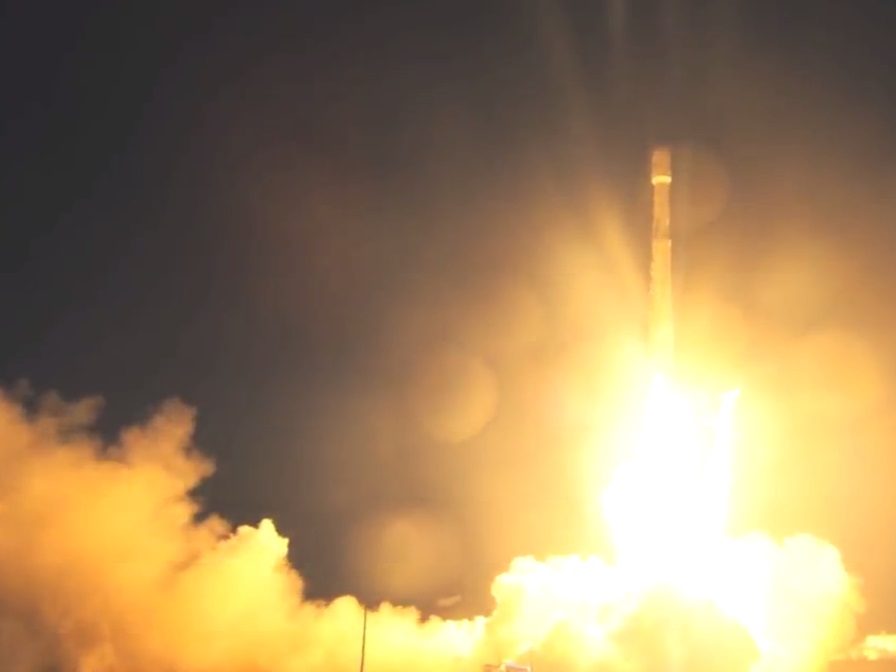Used SpaceX Rocket Launches 10 Communications Satellites Once Again
SpaceX capped a historic year with yet another successful launch by a pre-flown rocket.
A two-stage Falcon 9 booster lifted off from Vandenberg Air Force Base in California tonight (Dec. 22) at 11:27 p.m. EST (8:27 p.m. local California time, 0427 on Dec. 23 GMT), lofting 10 communications satellites for the commercial Iridium Next constellation. The launch lit up the evening sky over Southern California, providing a spectacular sight shortly after sunset for observers.
The Falcon 9's first stage also launched 10 Iridium Next satellites back in June, making Iridium the first SpaceX customer ever to launch twice atop the same rocket. [Reusable Rocket Launch Systems: How They Work (Infographic)]
SpaceX has now re-used Falcon 9 first stages on five separate missions, all of which launched this year. The company has also landed Falcon 9 boosters 20 times to date. But that tally did not increase tonight, because SpaceX did not attempt to land and recover this particular first stage for the second time, instead executing a landing burn and splashing down in the Pacific Ocean, according to the launch webcast. (The company has offered few details about the reasoning behind this decision. A few days before liftoff, a SpaceX representative told SpaceNews, "These are case-by-case decisions and are based on mission requirements and the needs of our manifest.")
SpaceX also launched previously flown Dragon cargo capsules on robotic resupply runs to the International Space Station twice in 2017. The second such flight, which lifted off on Dec. 15, featured a used Falcon 9 first stage. SpaceX had never before mounted an orbital mission with a pre-flown rocket and a pre-flown spacecraft.
Such re-use is key to slashing the cost of spaceflight, which will open the heavens to exploration, SpaceX founder and CEO Elon Musk has stressed. Indeed, complete reusability is a central feature of the BFR rocket-spaceship combo that SpaceX is developing to help humanity settle Mars.
SpaceX has now lofted 40 Iridium Next satellites across four different launches, with all of them happening this year. The company will fly four more missions for Iridium in 2018 to put 35 additional spacecraft in orbit, filling out the $3 billion Iridium Next constellation.
Breaking space news, the latest updates on rocket launches, skywatching events and more!
"Iridium Next will replace the company's existing global constellation in one of the largest technology upgrades ever completed in space," Iridium representatives said in a statement. "It represents the evolution of critical communications infrastructure that governments and organizations worldwide rely upon to drive business, enable connectivity, empower disaster-relief efforts and more."
Tonight's launch was SpaceX's 18th and final mission of 2017. That's a record for the company, which had never previously pulled off more than eight successful orbital launches in a single year.
2018 looks to be busy as well, and the action should pick up again soon: SpaceX has several missions scheduled for January, including the maiden flight of the company's Falcon Heavy rocket and the launch of the supersecret Zuma payload for the U.S. government.
Editor's note: If you captured an amazing photo of video of SpaceX's Falcon 9 rocket launch and would like to share it with Space.com for a story or gallery, send images and comments in to: spacephotos@space.com.
Follow Mike Wall on Twitter @michaeldwall and Google+. Follow us @Spacedotcom, Facebook or Google+. Originally published on Space.com.

Michael Wall is a Senior Space Writer with Space.com and joined the team in 2010. He primarily covers exoplanets, spaceflight and military space, but has been known to dabble in the space art beat. His book about the search for alien life, "Out There," was published on Nov. 13, 2018. Before becoming a science writer, Michael worked as a herpetologist and wildlife biologist. He has a Ph.D. in evolutionary biology from the University of Sydney, Australia, a bachelor's degree from the University of Arizona, and a graduate certificate in science writing from the University of California, Santa Cruz. To find out what his latest project is, you can follow Michael on Twitter.

